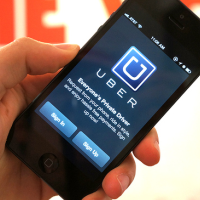PUC Says UberX and Others Are Legal, but Don’t Call It “Ride-Sharing”

The state Public Utilities Commission (PUC) issued a framework for regulating the controversial “ride-sharing” alternatives (UberX, SideCar, Lyft, etc.) to traditional taxicabs with one major caveat—stop calling it ride-sharing.
That didn’t stop virtually every media outlet covering the agency’s unanimous decision Thursday to refer to the new smartphone app-driven service, popping up in cities across the country, as ride-sharing and probably won’t for the immediate future as even the PUC couldn’t resist talking about the sharing of rides in its new regulations (pdf).
But the PUC was adamant that, in order to qualify for ride-sharing status under existing law, the services must be work-related and not provide rides for compensation. UberX and others do both. So the agency created a new category, Transportation Network Company (TNC), and drafted a new set of rules to govern them. They are regarded as the nation’s first.
Uber, Lyft, Sidecar and startups like them use variations on a common theme: Hailing a driver with a smartphone app is much faster than waiting for a cab service to dispatch someone from its fleet. Drivers are contractors wheeling around town in their own cars and people who summon a vehicle can watch its approach on their phones.
Most of the regs are safety-related and were gleefully embraced by the burgeoning industry’s major players, who have met stiff resistance at local and state levels in California from cab companies and politicians. The PUC briefly tried to stall the startups last October, then tentatively relented. San Francisco embraced them after a moment of heated resistance. Los Angeles officially banned them, but couldn’t stop them from operating. Cabbies stalked them and staged public protests. And their own drivers sued them for treating them as contractors, not employees.
The PUC established 28 rules and regulations for the TNCs, including requirements for $1 million-per-incident insurance coverage, a driver-training program and a 19-point car inspection. The companies must get a license from the PUC and conduct criminal background checks on drivers.
The San Francisco Cab Drivers Association responded by predicting the proliferation of TNCs would increase traffic congestion, pollution and safety hazards. Regulations governing taxis would be rendered meaningless, “leading to the decreased quality of passenger service for the disabled, elderly and disenfranchised who rely on taxis for transportation.”
Cab companies claim that even with the new rules, existing taxi regulations make running their business more expensive than the new competition and hinted at legal action.
–Ken Broder
To Learn More:
California Regulator Passes First Ridesharing Rules, a Big Win for Lyft, SideCar, and Uber (by Anthony Ha, TechCrunch)
California Regulators Approve Ride-Sharing Guidelines (by Donna Tam, CNET)
State OKs Uber, Lyft and SideCar (by Patrick Hoge, San Francisco Business Times)
State Adopts Regs for Ride-Share Services (by Kurtis Alexander, San Francisco Chronicle)
California Becomes First State in Nation to Regulate Ride-Sharing (by Marc Lifsher, Los Angeles Times)
Fight over Ride-Share Companies, like Lyft and Uber, Shifts to Courts (by Ken Broder, AllGov California)
- Top Stories
- Controversies
- Where is the Money Going?
- California and the Nation
- Appointments and Resignations
- Unusual News
- Latest News
- California Forbids U.S. Immigration Agents from Pretending to be Police
- California Lawmakers Urged to Strip “Self-Dealing” Tax Board of Its Duties
- Big Oil’s Grip on California
- Santa Cruz Police See Homeland Security Betrayal in Use of Gang Roundup as Cover for Immigration Raid
- Oil Companies Face Deadline to Stop Polluting California Groundwater





